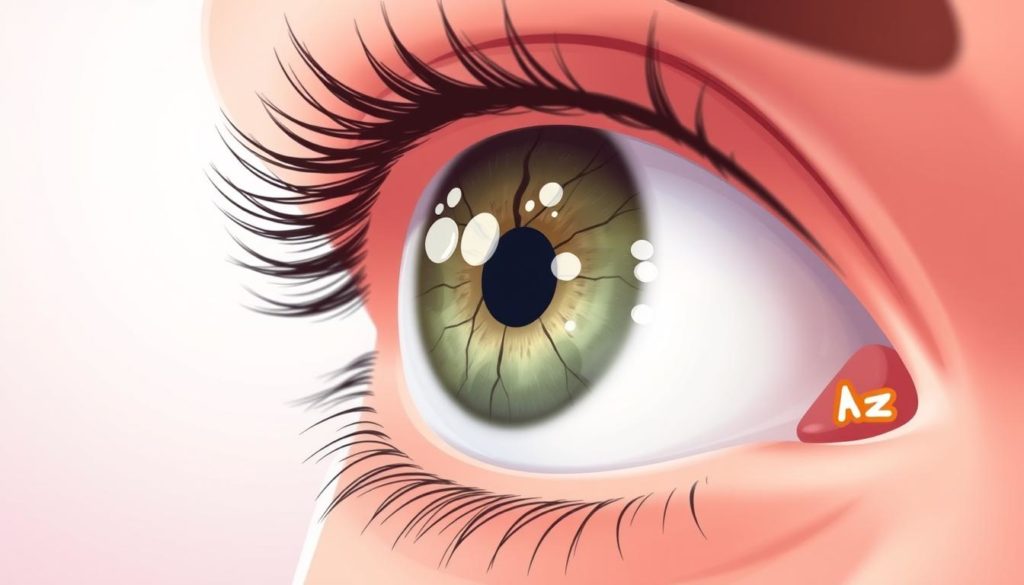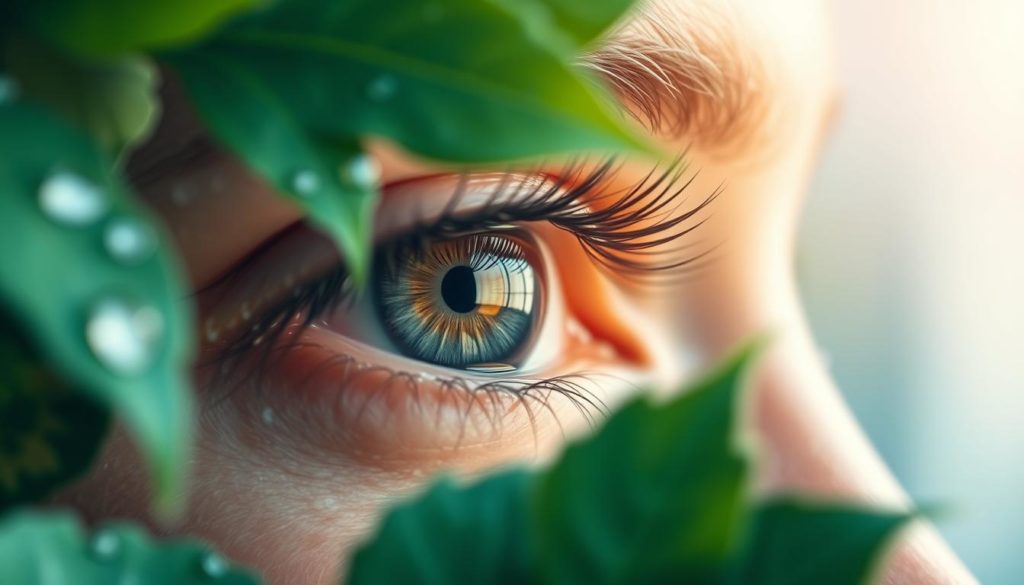Nearly 16 million Americans suffer from dry eye disease. It’s more than just feeling your eyes are dry now and then. Symptoms like constant dryness, irritation, and eye soreness show a deep link between eye health and your immune system.
Dry eye disease is called a “vicious cycle of inflammation.” It happens when there’s inflammation in the tear glands, cornea, or conjunctiva. This inflammation messes up the tear film’s job of protecting the eyes from irritants and germs. That puts eye health at risk.
Dealing with this inflammation is vital. If not managed, it can cause changes in tear production and even harm the eye’s nerves permanently.
Treatments often include artificial tears and ointments to ease symptoms. But, newer treatments are focusing on the immune response. They aim to bring back natural tear production and improve eye health.
To really understand dry eye syndrome, we must look into its symptoms and what causes it. Knowing this lets us manage inflammation better. This way, we can find a better solution for healthier eyes.
What is Dry Eye Syndrome?
Dry eye syndrome is a common issue known as keratoconjunctivitis sicca. It happens when eyes don’t make enough tears. Or when tears evaporate too quickly. This causes not enough lubrication for the eye’s surface.

Symptoms of Dry Eye Syndrome
Dry eye syndrome usually impacts both eyes and has various symptoms:
- Stinging and burning sensations
- Feeling of scratchiness or grit in the eyes
- Sensitivity to light
- Redness
- Sensation of having something in the eyes
- Difficulty wearing contact lenses
- Watery eyes, due to irritation
- Blurred vision or eye fatigue
These symptoms can get worse in certain places. Like on airplanes or in rooms with air conditioning. They also worsen during activities that need a lot of looking, such as using screens.
Causes of Dry Eye Syndrome
The causes of dry eye syndrome are varied and affect the tear film. This film is made of fatty oils, water, and mucus. Problems in any part can cause dry eyes.
| Factor | Description |
|---|---|
| Hormonal Changes | Changes during pregnancy, menopause, or with birth control can affect tears. |
| Autoimmune Disorders | Conditions like Sjogren’s syndrome and rheumatoid arthritis can cause lasting dry eyes. |
| Gland Dysfunction | Problems with the meibomian glands can stop the needed oils for tear stability. |
| Medication Side Effects | Antihistamines, antidepressants, and blood pressure medicines can lower tear making. |
| Environmental Conditions | Long times in wind, smoke, or dry air can make dry eyes worse. |
Knowing the causes and symptoms of dry eye syndrome helps in finding treatment. And in managing chronic dry eye effectively.
The Link Between Dry Eye and Inflammation
Understanding how dry eye connects with inflammation is key. It reveals the root causes of chronic conditions. Knowing this helps us find targeted therapies for dry eye relief.

How Inflammation Affects Dry Eyes
Inflammation harms normal tear production, leading to harmful inflammatory substances. This can happen due to eye problems or illnesses like Sjögren’s syndrome. Over time, chronic inflammation makes the tear film unstable and damages the eye’s surface.
Handling inflammation well is important. It helps stop dry eye problems from getting worse and offers relief.
Why Dry Eyes Trigger Inflammation
Dry eyes can lead to inflammation, making it harder to fix the issue. Stress from hyperosmolar tears causes the body to create inflammatory substances. This cycle can make dry eye a long-term problem. To get better, treatment needs to focus on both dry eye and inflammation.
Common Triggers of Eye Inflammation
Eye inflammation has many causes, from your surroundings to health issues. Knowing what triggers it is key to stop inflammation and keep eyes healthy.
Environmental Factors
Things around us often cause eye inflammation. Wind, smoke, and not enough moisture can make tears evaporate quicker. This leads to symptoms of dry eyes.
Being in air conditioning too long or around allergens like pollen also plays a big part. We need good remedies for eye inflammation to fight these triggers.
Medical Conditions
Health problems can also lead to eye inflammation. Things like rosacea or immune system issues can harm tear glands. This means tears can’t do their job well.
Not blinking enough or having swollen eyelid glands can make dry eyes worse. These issues show why it’s crucial to find solid eye health solutions.
| Trigger | Impact | Recommended Action |
|---|---|---|
| Wind and Smoke | Increases tear evaporation | Use protective eyewear |
| Allergens | Causes allergic reactions | Use antihistamine eye drops |
| Rosacea | Affects meibomian glands | Consult with an ophthalmologist |
| Autoimmune Diseases | Reduces tear quality and quantity | Follow a specialized treatment plan |
It’s vital to understand what causes eye inflammation. This way, we can treat and prevent it properly. By tackling both environmental and health issues, we can keep our eyes healthier and avoid long-term inflammation.
Dysfunction in Tear Production
There are two main reasons why your eyes might not make enough tears. One reason is not enough liquid is produced. The other reason is tears evaporate too fast from the eye’s surface. Understanding these problems is key to managing dry eyes effectively.
Decreased Tear Production
As people get older, their eyes produce fewer tears. This is because the tear glands don’t work as well. Illnesses like Sjögren’s syndrome or problems with the thyroid can also reduce tear production. Damage to nerves or certain medications are also culprits.
To tackle this, doctors focus on the root cause. Then, they try to boost the body’s ability to make tears through treatment.
Increased Tear Evaporation
Some conditions make tears vanish quicker than they should. These include meibomian gland dysfunction and diseases of the lid margin. Things like wind and dry air can make it worse.
This messes up the tear film on your eyes, leading to dry eye syndrome. The treatment goal is to improve the tear film and stop eyes from drying out too much.
| Factors | Examples |
|---|---|
| Decreased Tear Production | Sjögren’s Syndrome, Thyroid Disorders, Aging |
| Increased Tear Evaporation | Meibomian Gland Dysfunction, Lid Margin Diseases, Environmental Factors |
Treatment Options for Dry Eye and Inflammation
Many treatments exist for dry eye syndrome and inflammation. They include over-the-counter options and lifestyle changes. These methods aim to alleviate dry eye symptoms and improve eye health.
Artificial Tears and Ointments
Artificial tears and ointments offer relief for dry eyes. They moisturize the eye’s surface and fight dryness. Various formulas are available, with some designed to keep eyes moist longer.
Anti-Inflammatory Medications
New treatments target the immune system with anti-inflammatory drugs. These drugs stop inflammation, helping tear production return to normal. They offer a longer-lasting solution than temporary relief options.
Home Remedies and Lifestyle Changes
Home remedies and lifestyle changes also play a big role. Using humidifiers, cutting down screen time, and eating foods rich in vitamin A and omega-3s help. Avoiding smoke and pollutants also eases dry eyes and boosts overall eye health.
| Treatment Options | Benefits | Considerations |
|---|---|---|
| Artificial Tears and Ointments | Immediate moisture to the ocular surface | Temporary relief; may require frequent application |
| Anti-Inflammatory Medications | Addresses the root cause of inflammation | Requires prescription; potential side effects |
| Home Remedies and Lifestyle Changes | Non-invasive and holistic approach | Requires consistent efforts and lifestyle adjustments |
How Chronic Dry Eye Leads to Ongoing Inflammation
Chronic dry eye can start a cycle of never-ending inflammation. This has serious outcomes long term. The continuous swelling can change your eye nerves, making discomfort worse. It can even kill eye cells, harming your vision and eye health overall.
Long-term Impact on Eye Nerves
Inflammation over time affects the nerves, changing how your eyes feel. This makes managing chronic dry eye harder, increasing pain. Sometimes, this damage makes usual treatments less effective, needing more advanced care.
Permanent Eye Conditions
Without stopping inflammation early, lasting eye issues can arise. These include keratitis and corneal ulcers, risking your vision. Understanding this cycle helps us find better eye health solutions to avoid permanent harm.
| Chronic Dry Eye Issues | Resulting Conditions |
|---|---|
| Nerve Damage | Altered Sensations |
| Cell Death | Keratitis, Corneal Ulcers |
| Persistent Inflammation | Vision Loss |
Preventing Dry Eye and Inflammation
To stop dry eye syndrome and inflammation, we need a plan that covers many areas. This plan should handle inflammation. It should also look at environmental and lifestyle choices that cause dry eyes.
Keeping indoor air moist is key to stopping inflammation. Humidifiers make the air wetter, which cuts down on eye irritation. Wearing eye protection also helps. It keeps your eyes safe from strong winds and dry air outdoors.
Long periods of reading or looking at screens can make dry eyes worse. It’s very important to take breaks to relax your eyes. Also, keep screens below eye level to avoid straining your eyes too much.
Think about the air quality too. High places and polluted areas can dry out your eyes. Paying attention to air quality and making changes when needed helps a lot. Putting in artificial tears keeps your eyes moist. This is a good way to manage inflammation and avoid dry eye problems.
Staying away from things that make your eyes drier can lower the risk of inflammation. Making these changes can really help with dry eye issues. They also support overall eye health.
- Use humidifiers to add moisture to indoor air.
- Wear protective eyewear to shield from wind and dry air.
- Take breaks during prolonged visual tasks.
- Be mindful of air quality at high altitudes.
- Position screens below eye level.
- Use artificial tears to maintain eye lubrication.
By focusing on these strategies, you can really improve your eye comfort and health.
Understanding the Role of the Immune System
The immune system plays a key role in both causing and fighting inflammation in dry eye disease. It starts off helping the eye heal. But if inflammation doesn’t stop, it can harm the eye. Balancing inflammation is key for healthy eyes.
We need to understand the immune system to treat dry eye better. Treatments that control the immune response are becoming popular. These advances are important for keeping eyes healthy.
Here’s a detailed comparison of common inflammation treatments and their focus areas:
| Treatment | Focus Area | Effectiveness |
|---|---|---|
| Artificial Tears | Lubrication | Short-term relief |
| Anti-Inflammatory Medications | Reducing inflammation | Moderate to high effectiveness |
| Immunomodulatory Therapies | Regulating immune response | Long-term relief |
Effective management of inflammation requires knowing these treatments well. The right treatment can greatly improve eye health. It also helps with long-term relief from dry eye.
Impact of Hormonal Changes on Eye Health
Hormonal changes greatly affect our eyes, often leading to dry eye syndrome. These changes, due to age or gender-specific reasons, are important. They guide us in finding the right ways to manage eye health and inflammation.
Age-related Changes
The hormones in our bodies change as we get older, reducing tear production. This can cause dry eye syndrome and more inflammation. Knowing about these changes helps us find the best ways to care for our eyes.
Gender-specific Factors
Women are more prone to dry eye syndrome because of hormonal changes. This happens during menopause, pregnancy, using contraceptives, or hormone therapy. It’s crucial to focus on managing inflammation due to these changes.
| Factor | Impact on Eye Health | Solutions |
|---|---|---|
| Postmenopause | Increased risk of dry eye syndrome | Hormone-focused eye health solutions |
| Pregnancy | Fluctuating tear production | Regular eye check-ups and artificial tears |
| Contraceptives | Potential changes in tear film stability | Consulting with healthcare providers |
Lifestyle Tips for Managing Dry Eye and Inflammation
Making key lifestyle changes is essential for healthier eyes, especially with dry eye and inflammation. It’s important to include foods rich in omega-3 fatty acids in your diet. Fish like salmon are great sources of these nutrients, which help reduce eye dryness and improve tear production. Managing inflammation is also key.
Limiting screen time helps keep your eyes healthy. Eyes can get worse if you look at screens too much. To help, try the 20-20-20 rule: every 20 minutes, look at something 20 feet away for at least 20 seconds.
Quitting smoking is crucial for eye health. Smoke can make eye problems worse by increasing irritation and inflammation. To help keep your eyes moist, use a humidifier to improve indoor air quality. This helps prevent inflammation.
Using lubricating eye drops can also keep your eyes comfortable. Choose drops without preservatives to avoid irritation. For more tips, including details on diagnosis and treatment options, check the Mayo Clinic page.
FAQ
What is dry eye syndrome?
Dry eye syndrome is when your eyes don’t make enough tears or they dry too fast. This leaves your eye surface not well-lubricated.
What are the symptoms of dry eye syndrome?
You might feel stinging, burning, or like something is in your eyes. You could also notice redness, sensitivity to light, trouble with contacts, watery eyes, blurry vision, and tired eyes.
What causes dry eye syndrome?
It can happen due to hormonal changes, autoimmune diseases, gland issues, side effects from drugs, and being in certain environments. Trouble with any part of the eye’s tear layer can cause dry eyes.
How does inflammation affect dry eyes?
Inflammation messes up how tears work and damages eye tissues. This leads to more problems with the tear film and makes dry eye symptoms worse.
Why do dry eyes trigger inflammation?
When eyes are too dry, they react by getting inflamed. This can make dry eye problems even more uncomfortable by starting a cycle of dryness and inflammation.
What are common triggers of eye inflammation?
Things like wind, smoke, not enough humidity, certain medical conditions, and gland issues can all cause inflammation. This makes dry eye symptoms more likely.
What are the main types of dysfunction in tear production?
Problems with making tears can come from getting older, some illnesses, or certain meds. Other issues, like gland problems, diseases on the eye’s edge, or the environment, can make tears evaporate too fast.
What treatment options are available for dry eye and inflammation?
You can use artificial tears or ointments to help. There are also anti-inflammatory meds. Changing your lifestyle, like less screen time and using humidifiers, helps too.
How does chronic dry eye lead to ongoing inflammation?
Having dry eyes for a long time keeps inflammation going. This can hurt the nerves in your eyes, causing more discomfort and possibly damaging your cornea over time.
What strategies can help prevent dry eye and inflammation?
Use humidifiers, wear eye protection, take breaks from screens, keep the air clean indoors, and use eye drops as needed. These steps help keep your eyes wet enough.
How does the immune system impact dry eye disease?
The immune system is key in dry eye-related inflammation. Controlling the immune reaction with certain treatments improves eye comfort and health.
What impact do hormonal changes have on eye health?
Changes in hormones, like during menopause or when using birth control, can lower tear quality and amount. This makes dry eye more common and helps us find better ways to deal with it.
What lifestyle tips can help manage dry eye and inflammation?
Limiting screen time, keeping air clean, eating foods high in vitamin A and omega-3s, stopping smoking, and using eye drops wisely can help. These habits reduce dry eye and inflammation symptoms.


